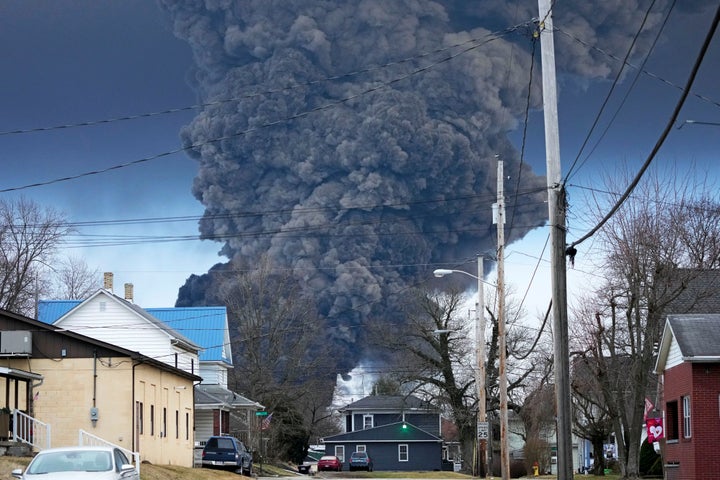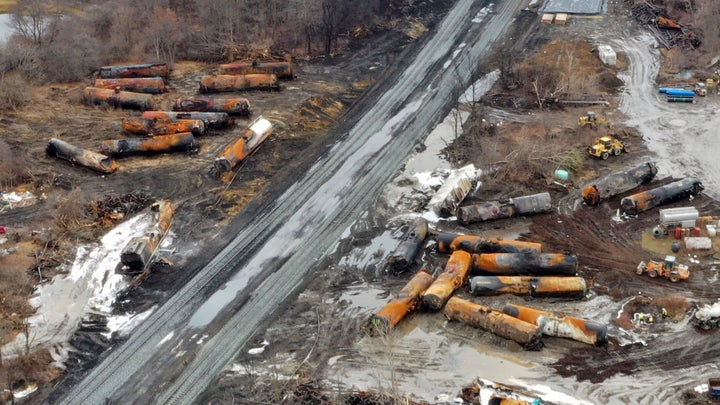The testing that Ohio authorities relied on to declare the municipal water in East Palestine safe to drink after a disastrous train derailment was funded by the railroad operator itself and did not initially comply with federal standards, HuffPost has learned.
Ohio Gov. Mike DeWine (R) on Wednesday afternoon announced that new testing from five wells that supply the town’s municipal drinking water “showed no evidence of contamination” after a Norfolk Southern freight train loaded with tons of hazardous materials derailed in the area on Feb. 3.
“With these tests results, Ohio EPA is confident that the municipal water is safe to drink,” DeWine’s office wrote in a news release.
On its web page about the derailment, Ohio Environmental Protection Agency links only to railroad-funded preliminary test results, which it said “so far confirm that … there is no indication of risk to East Palestine Public Water customers.”
The Columbiana County General Health District separately sampled East Palestine’s public water system last week. But as of Friday, the county’s testing results had not been made public. Laura Fauss, the public information officer for the Columbiana County General Health District, told HuffPost it did not receive preliminary results of its sampling from the lab until about 5 p.m. Wednesday — approximately two hours after the governor’s office sent out its water quality update.
DeWine’s office did not respond to HuffPost’s request for comment Friday, other than to send links to the governor’s press conference that day and the Ohio EPA website.
Although the drinking water in East Palestine may indeed be safe, as officials have repeatedly stressed in recent days, independent experts argue the initial batch of samples that a consulting firm hired by the rail company collected and submitted to the lab should not have been used to make such a determination. The lab report on the railroad-funded sampling indicates the samples were not handled in accordance with federal Environmental Protection Agency standards.
Sam Bickley, an aquatic ecologist at Virginia Scientist-Community Interface, an advocacy-focused coalition of scientists and engineers, alerted HuffPost to the sampling errors and called the report “extremely concerning.”
“Their results that claim there were no contaminants is not a reliable finding,” he said via email. “I find this extremely concerning because these results would NOT be used in most scientific applications because the samples were not preserved properly, and this is the same data they are now relying on to say that the drinking water is not contaminated.”

AECOM, the Dallas-based consulting firm contracted by Norfolk Southern, sampled untreated water from the five municipal wells, each about a mile from the derailment site, as well as treated municipal water on Feb. 10. Those samples were analyzed by Eurofins TestAmerica Laboratories, an environmental testing lab in Canton, Ohio, on Feb. 13 and 15, according to Eurofins’ analysis. Five of the six collected samples had pH, or acidity, levels that exceeded the 2 pH limit allowed under the EPA method listed in the analysis for detecting volatile organic compounds, rendering them improperly preserved.
One sample also “contained a large air bubble in its vial, while the EPA method requires that sample bottles should not have any trapped air bubbles when sealed,” the report states.
David Erickson, a hydrogeologist and the founder of Water & Environmental Technologies, an environmental consulting firm in Montana, called the sampling “sloppy” and “amateur.”
“Due to improper sampling protocols, there could have been more contaminants in the sample than what showed on the analytical,” Erickson said, explaining that a bubble in a sample is problematic because contaminants can move into the airspace and go undetected.
Norfolk Southern dismissed the issue as a recording error at the Eurofins lab that ultimately did not affect the test results. It said it directed a second analysis of the same samples.
“Though the initial data was valid, we wanted to ensure compliance with EPA standards, and proactively asked the lab to rerun the samples with the remaining preserved vial from each sample,” Connor Spielmaker, a spokesperson at Norfolk Southern Corp., said in an email. “Reanalysis of the samples ensured method compliance and again produced a result indicating safe water. The lab did not update the comments to note the re-testing and erroneously included the comments from the initial test.”
A final lab report of AECOM’s sampling was expected as soon as Friday and would include updated information on the retesting, Spielmaker said.
James Lee, a spokesman for Ohio EPA, acknowledged AECOM’s samples were not properly preserved or acidified but said they were “acceptable due to the next-day processing at the laboratory.” (The report shows the samples were received at the lab the same day as collection and first analyzed three days later and then again two days after that.)
“Laboratory validation reports will be prepared and will address this issue, but the results are valid,” he said. “For all Drinking Water Wells sampled, the Columbiana County Health District accompanied the contractor and collected their own split sample that was sent to a separate lab. We have received those results and they are consistent with the contractor’s results, both showing no contaminants associated with the derailment.”
Lee acknowledged Ohio EPA didn’t receive the county results until after the state declared the municipal water safe to drink.
“Our decision to announce the all clear was based on the samples we received earlier in the day, but it was great to have additional confirmation from Columbiana County Health Department,” Lee said.
The federal EPA has not done its own sampling of municipal water in East Palestine. During a press call with reporters Friday, an official in the Biden administration said “all of the sampling that’s been done in Ohio has been joint, not Norfolk Southern alone. … It’s been with the Columbiana County Health Department, collecting samples along with Norfolk Southern and sending those as split samples to two different labs for verification.”
The messy collection and rollout of preliminary water quality data is likely to further frustrate the residents of East Palestine as they deal with the aftermath of the toxic train disaster. Many have expressed distrust for local, state and federal authorities as they search for answers about how the derailment has and will continue to affect human health and the environment.
The primary concern in the disaster has been the spill of hundreds of thousands of pounds of vinyl chloride, a common and highly flammable organic chemical that is used in the production of plastics and has been linked to several types of cancer. Fearing a catastrophic explosion, authorities conducted what they described as a “controlled burn” of the vinyl chloride three days after the crash.

In recent days, Ohio officials have repeatedly said testing of East Palestine’s municipal water system “show no detection of contaminants.” The analytical report of Norfolk Southern’s testing, however, shows very low levels of dibutyl phthalate, a common chemical used to make plastics more flexible, in three well water samples.
Erickson said it is possible that the dibutyl phthalate could have been in the air — the result of incomplete combustion during the controlled burn — and entered into water sample containers when they were collected.
“I can’t say that with any conviction, but that is not a contaminant that we typically see in drinking water wells,” he said.
Lee, at Ohio EPA, said the dibutyl phthalate is associated with chlorination, is “not unexpected” and that low-level detection “is common due to cross-contamination at the lab.”
Eurofins declined to comment, citing contractual obligations and confidentiality for its client.
Dibutyl phthalate is not linked to cancers in humans, but exposure can cause headaches, dizziness, eye and throat irritation, nausea and seizures. It has been shown to cause reproductive harm in animals.
Erickson and Bickley argue the municipal water in East Palestine should have been immediately resampled when the lab flagged that samples were not preserved in accordance with EPA’s handling method.
“They should go out and resample,” Erickson said. “Do it right.”
As of Friday evening, the only publicly available data on the quality of water in East Palestine’s municipal system was collected by the railroad’s contractor. The county health district said it would post final results from its sampling to its website once they come in.
Lee, of Ohio EPA, said sampling of the public water system wells is continuing.

